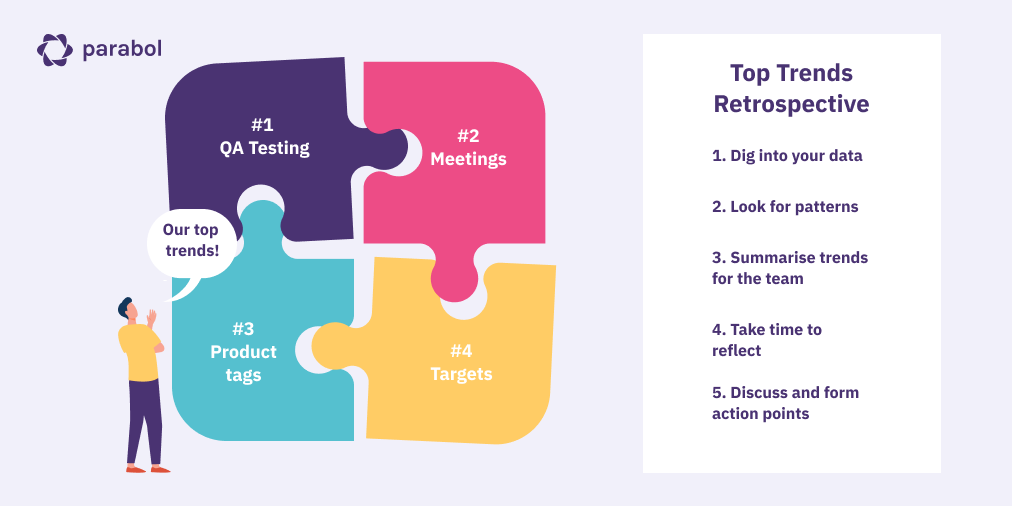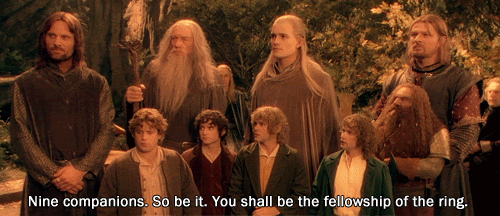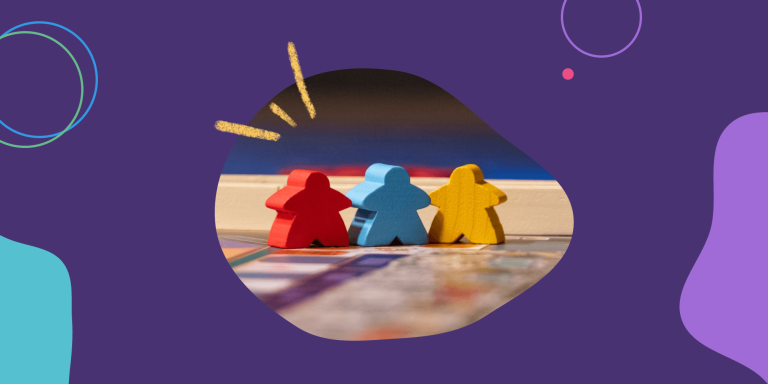5 Sprint Retrospective Ideas for the Year End

December is a month for family, celebration and good cheer. It’s also a month where people start looking back and thinking about how it all went.
For many, the end of the year is the only time they look back and evaluate their lives, work, and happiness in a more structured way.
By contrast, Agile teams working in two-week sprints will have looked back on their work 26 times in retrospectives by the end of the year.
But just as Frodo had one ring to rule them all, you can create one retro to rule them all – consolidate your learnings with one retrospective to reflect on the whole year.
This blog includes five retrospective ideas to help you wave goodbye to this year and welcome in the next:
1. Marie Kondo Retrospective
Get Organized and Leave the Bad Stuff Behind

Some teams find value in using year end to put things in order and do a little clean up. The Marie Kondo retrospective helps teams start the new year with a fresh slate, ready to execute!
This retrospective helps teams discover what sparks joy and what to wave goodbye to.
Now, tidying up doesn’t just mean refining your backlog, it means thinking about your working practices to find a more fulfilling route forward.
The Marie Kondo retrospective offers a fresh take on three-prompt retrospective formats that’s suited to looking back over a longer period of time and making resolutions for the new year.
Here’s how it works:
⭐ What Sparks Joy?
One of Marie Kondo’s key ideas is that you should only keep things in your life that ‘spark joy’. So encourage your team to think about what tools, processes, or even types of work bring them that satisfaction of a job well done or that burst of excitement that kept them going during tough times.
Example: The pair-work Joe and I did on the new app felt really good. We learned a lot from each other and it was fun to jam together.
Thank You & Goodbye
Life is full of ups and downs. That’s why this prompt encourages the team to think about things they want to acknowledge, accept, and move on from. This prompt bakes a sense of acceptance and calm into the idea of leaving behind ideas or processes that just didn’t work out. But it encourages the team to also think about what they’ve learned from a task or process before letting it go.
Example: I learned a lot from the migration process this year, but I am really happy to say goodbye to it. Next time we do something like that I want to plan better to reduce the stress.
♻️ Things to Up-Cycle
The year end isn’t only a time for letting negative energy slip away and embracing the things that spark joy. It’s also a time for making improvements. This prompt helps the team think about what parts of their existing work, codebase or processes could use an extra bit of love. These are the things that spark joy but have seen better days.
Example: I like our tasking system, but I got confused with it during the year. I’d like to add clearer tags, so I can see all the tasks towards a certain goal, for example.
Marie Kondo’s philosophy is all about restoring inner calm and peace in your team. It’s about organizing your work and making processes lightweight and user-friendly. So don’t delay it until spring-cleaning, try the Marie Kondo retrospective and start the year with a fresh approach.
2. Top Trends Retrospective
Dig into Your Trending Topics for the Year

By the time December comes around, you’ve got a whole 12 months of retrospective data to dig into. With a bit of work, Scrum Masters or facilitators can pull together the trending topics of the year and dig into them in more detail.
Think of it like Spotify Wrapped for your retrospectives.
The goal of this retrospective is to help the team take a macro view on their most common or recurring tensions during the year. With 12 months of data under your belt you can investigate why specific topics cropped up so much, what was proposed to resolve them, and if those issues are still causing problems.
This format is similar to the timeline retrospective, but puts the onus on the Scrum Master or Facilitator to pull together the data in advance, to maximise the time for discussion.
Here are the steps you need to take:
- Dig into your data
The Scrum Master or Team Lead should dig into the data from the retrospectives for the past 12 months. If you’re using an online tool, you might download that data as a CSV file or simply populate it into an excel sheet or whiteboard tool.
Look for patternsThe Scrum Master or Team Lead should now search for common themes and group those together, just like in a regular retrospective. Take the four or five groups with the most items in them and take these forward for your retrospective.
- Summarise trends for the team
During your retrospective meeting, summarise for the team what the most common tensions were during the year and summarise the contents of those reflections, to refresh the team’s memory.
- Take Time for reflection
Encourage the team to now write up new reflections for the 4-5 trending topics. These will form the template prompts for your retrospective. Are there still problems with those topics? Did the team manage to resolve the issue and find a solution? How are you feeling about that topic?
- Discuss and set action points
Hold a team discussion about the reflections that came up on the trending topics. It might be that some items came up a bunch in the year but were resolved. Other, more persistent issues, might still need to be solved, so you can gear your team towards setting priorities for improvements to make in the new year. Having some defined things you want to start working on in the new year might also get your year off to a better start and help you avoid the ‘blank page’ issue when it comes to team processes.
This retrospective takes a data-driven approach to help teams take a broader view on their tensions across all months of the year. But it may also help to instil the value of the retrospective process when the team will have determined certain trending issues to have been solved.
3. Highlights & Lowlights Retrospective
A Retro to Evaluate the Best of Times and the Worst of Times

As Charles Dickens wrote in the opening of A Tale of Two Cities: “It was the best of times, it was the worst of times”.
And as science would have it, those tend to be the times we remember the most.
According to American Psychologist Daniel Kahneman, some of the things we remember best are the emotional peaks – the ups and downs of life.
The highlights and lowlights retrospective plays with that idea to help teams think about their highlights reel and… well, the lowlights, too.
The goal is to get the team thinking about how to replicate their highlights and how to avoid the lowlights in future.
Here’s how it works:
Highlights
Ask your team to think about the best moments of the year. These could be times when the team worked together efficiently and without friction, when a work experiment paid off in spades, or when a new process made your work life much better. Encourage your team members to also think about their personal highlights – when did they feel like a superhero in their job, when were they happiest?
Example: Adding captions in multiple languages made our latest game so much accessible, and I think players really appreciated it. It was awesome to see player reviews in different languages!
Lowlights
Were there times in the year when things just didn’t go right despite your best efforts? Ask your team to think about times when there were big problems or when they felt personally unhappy in their job. Use these reflections as a springboard to discuss how to make things better next year.
Example: Our pre-launch prioritization made me feel really anxious. Pressure from above meant that **everything** was suddenly a priority. It wasn’t a sustainable way of working.
Chances are that the dark points in the year may still feel pretty fresh in the memories of your team, so be sensitive and encourage open-ness during this discussion. It’s important to leave negative energy behind and move forward with a positive boost – so if you notice your team morosely recounting the lowlights instead of being energised by the highlights, the facilitator might need to do some extra work to steer the team towards a positive mindset.
This retrospective forces a really honest conversation about the highs and the lows. On that basis, this retrospective is recommended for teams that have a strong working relationship and good psychological safety.
4. ️ New Year’s Resolutions Retrospective
Reminisce About the Past and Plan for the Future

Your team spends a lot of time working together during the year, so it’s nice idea to chart your progress and admire the journey you’ve taken. Not least in order to consolidate all your learnings for the year and discover paths for growth in the next 12 months.
In this retrospective, teams look backwards over the year, and also make resolutions for the year ahead.
And you know that warm-fuzzy feeling you get when thinking back on great achievements, hilarious occasions, or moments when you felt gratitude?
This retrospective also tries to kindle that elusive feeling and keep things light-hearted by prompting teams to reflect on some of their best memories together.
How it works:
Growth & Wisdom
Personal and team growth helps teams feel that elusive state of self-actualisation that forms the pinnacle of Maslow’s hierarchy of needs. This prompt encourages individuals to think hard about how they have grown in their role and also how the team has made continuous improvement.
Example: Compared to last year our team’s code and review process was way more streamlined. It’s been great to see Aliya and Chris step up and help with this. We are shipping way more quickly now.
Greatest Hits
Whether it’s goofy jokes, awkward moments, or big wins for your team, take a moment to recall your greatest hits for the year. In our experience, the funnier or more goofy, the better. But you can also encourage your team to also think about moments where it felt as if the team were in a state of ‘flow’ or working together like a well-oiled machine.
Example: The regular cameos from Mike’s cat brought me joy all the way through the year. Especially when she would just sit on his shoulders and refuse to budge
️ New Year’s Resolutions
Everyone has things they want to achieve in life – this is the time to write them down for your retrospective. Encourage your team to think about what could have been better in the year and how improvements can be made. Resolutions can cover personal growth, process fixes or resolving common issues that came up in retrospectives during the year.
As a rule, your resolutions should come out of doubling down on something that went well, or resolving what might have gone wrong or can be improved.
Example: I want to become more familiar with DevOps work and learn more about penetration testing. This all feels abstract kind of abstract right now, but I think learning about this might improve how I build.
This retrospective gives you the time to reflect on the most human parts of working together, while focusing on team growth – past and future. If multiple people have similar resolutions, group them together and form pair-work groups or tandems to help each other out.
5. Always Be Learning Retrospective
Help your Team Grow in the New Year

We’re used to talking about Scrum Teams as a solid unit of folks all pulling towards the same goal. But each team is made up of complex human beings with different goals, interests, and approaches to learning.
This retrospective helps team members think as individuals about what they learned in the year and what they want to learn next year.
This can help Scrum Masters or facilitators understand the personal growth targets of each person on the team and see their growth trajectory.
For this retrospective you might want to encourage people to own their retrospectives or abstain from using anonymous reflections.
What I learned in [current year]
This prompt gives your team members the time to deeply reflect on what they learned in the year. This could include technical learnings, soft-skills, tips and tricks of the trade, or even things they have learned about colleagues. We like to include a couple of those personal insights amid the more serious things to keep the retro fun and light-hearted.
Example: I learned some CSS in the year to help the marketing team with some of the website templates. This was kind of fun and different to my regular work. CSS was easier to get the hang of than I thought it would be.
What I want to learn in [next year]
Encourage your team members to treat this prompt like a list to Santa. Team members should put everything they want to learn in their work out on the table, no matter how large or small. Individual team members can take these reflections and keep them as personal reminders of what they set out to achieve for the next year.
Example: I want to spend some time working on my written communication. When we’re all working remotely I realised how important it is to communicate clearly, so I want to improve how I communicate to maximise clarity.
This exercise may reveal interesting constellations of growth interests that can be built upon in the next year. It also encourages team members to find a way to learn from each other.
If Matt learned CSS in the year to help out the marketing team and Gretchen expressed that this is one of her goals for the next year, then there’s an opportunity to learn from each other.
But it also helps to share learnings around your team that otherwise may have lived in only one person’s head. Expect to hear a few folks saying “Oh, I never knew that!” as all your team’s learnings are put out on the table.
Year End Retrospectives Help Teams Chart Their Journey Together
Year end retrospectives are an important practice for consolidating your learnings for the whole year. But they also help teams chart their journey together.
Some reminiscing about the good times and the bad times, the ups and the downs, helps teams form stronger bonds.
Charting the journey, and looking back on the road travelled helps teams feel more like a fellowship of travellers who contribute their own unique skills to the party and play a key role in the team’s success.

And who doesn’t want to be part of a fellowship like that?
So whichever retrospective you run at the end of this year, spend some time using the opportunity to:
- Build team spirit, motivation and culture
- Consolidate your learnings for the year
- Chart a bold path forward for the year ahead
All that leaves me to say is happy new year and happy retrospecting! You can run all of the templates in this article using Parabol!








